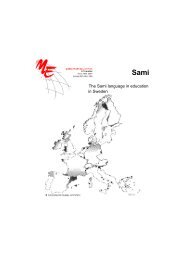Multilingual Early Language Transmission (MELT) - Mercator ...
Multilingual Early Language Transmission (MELT) - Mercator ...
Multilingual Early Language Transmission (MELT) - Mercator ...
Create successful ePaper yourself
Turn your PDF publications into a flip-book with our unique Google optimized e-Paper software.
2.6 Summary of best practices in the four regions<br />
In the <strong>MELT</strong> project four partners (Fryslân, Finland, Wales, and Brittany) learned from each<br />
other’s experience in the different pre-school settings. Similarities and differences became<br />
evident during the project. The information in the previous sections shows that most<br />
children under four attend the preschool provisions in the four regions on a voluntary basis.<br />
Figure 2.1 (p. 18) presented an overview structuring the age for starting pre-school as well as<br />
the age for starting compulsory primary school in the different countries. (of ages of starting<br />
pre-school and the ages of starting compulsory primary school). Those ages depends on the<br />
local authorities, municipality and parents. The <strong>MELT</strong> partners know that the kind of<br />
compulsory primary schooling differs in the four countries.<br />
In Wales and Fryslân children start primary school at the age of 4. However, education is<br />
only compulsory from the age of 5. In Brittany children start primary school starts at the age<br />
of 6, and in Finland at the age of 7. Therefore, the <strong>MELT</strong> project focuses on the common preschool<br />
years: 0-4 years.<br />
During the two-year project there was every opportunity to use each other's expertise and<br />
best practices in the field of pre-school immersion and mother tongue education before<br />
primary school. However, the four <strong>MELT</strong> partners had to determine the definition of preschool<br />
education and had to agree on the best pedagogical approaches and materials. The<br />
products had to be developed to everyone's satisfaction, so that they are appropriate for<br />
each region in Europe. In chapter 2.1 the definition of pre-school, as used in the <strong>MELT</strong><br />
project has been presented. Chapter 3.3 will present a definition of <strong>Multilingual</strong> <strong>Early</strong><br />
<strong>Language</strong> <strong>Transmission</strong> (<strong>MELT</strong>).<br />
The previous sections show that most states developed a national curriculum for pre-school<br />
education for children aged 2-7. In the four regions most pre-school institutions adjust the<br />
national curriculum to their regional situation and in some settings the minority language is<br />
included in the daily programme.<br />
One of the similarities is that most participating pre-schools in the four regions work in a<br />
thematic and project type manner. Some even have developed their own materials in the<br />
minority language.<br />
Unfortunately, some pre-schools have no explicit conscious language policy. Noted that a<br />
conscious language policy within the pre-school setting is an important aspect when it<br />
concerns multilingualism in the daily life of young children. However, putting an conscious<br />
language policy into practice requires practitioners to have the providing skills to offer young<br />
children a rich language environment, including enough input in the minority language.<br />
In the four regions some pre-school provisions changed the national curriculum and applied<br />
it to their own regional situation and sometimes provisions use extra or new materials and<br />
approaches in the minority language only. In Wales and Fryslân there are pre-schools that<br />
use a character (“Dewin” in Wales and “Tomke” in Fryslân) to stimulate and promote the<br />
minority language; the characters speaks and understands Welsh (Dewin) and Frisian<br />
(Tomke). Such a ‘character approach’ is an easily accessible and recognisable way for<br />
parents, practitioners and children to speak the minority language. Dewin and Tomke<br />
45



